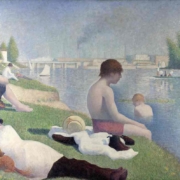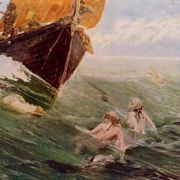Presentation, Reflections on the adolescent group with particular reference to trauma and accidents
The present issue deals with three closely connected arguments: adolescence, group and accidents.
When adolescence from a latent quietude bursts onto the scene, it evokes metaphors that more often than not have to do with the negative effects of trauma. The transformations that come about in puberty brusquely invading the experience of the Self, are often seen as an accident (‘adolescence suddenly hit me’, explains a young girl pointing to her chest with a frightened air of someone who had been hit by a car) these transformations have a certain momentousness on the continuity of existence.
Similarly, the accident –the primary cause of death between the ages of 15 and 24 years, is not as it seems a casual event, but is an expression of ‘acting-out’, in other words an action with two sides to it, both equally significant, on one hand the action offers the subject a flight from awareness, and on the other, stages a trauma without speech.
When we consider the group we wonder what relation there is between group, adolescence and accidents. Frequently, parents and teachers ask themselves (and ask us also), what are the risks connected to the adolescent and the group, often threateningly seen as a ‘gang’.
We have observed that adults usually see the adolescent/individual (‘their’ son or‘their’ pupil), substantially level-headed and the group of adolescents as a risk factor. On the contrary, adolescents perceive the relation between risk and group in a completely different way: failing a year at school, bad health or losing the affection of their parents is not a priority problem. The most extreme risk for an adolescent is losing his/her place in the group, and so he/she believes it’s worth the trouble to expose oneself to risk. I use ‘worth the trouble’ in the literal sense, in as much as an adolescent gets no pleasure out of risking, even though it may seem that way to us. We adults may believe that young people are ‘irresponsible’ and they risk for ‘recklessness’ or for unbridled hedonism. In reality adolescents risk with fear and negation of danger, and a hypo-maniacal attitude is only a thin coat of paint on the anxiety for their passivity and mortality that are hastening to be represented on some stage.
So as we see, adolescence, group and accidents are closely linked. This connection gives rise to the most amazing metaphors on adolescence for instance, the story of the trapeze artist who launches himself from a platform to grab a flimsy, swinging trapeze. This well-known metaphor thanks to which Erickson describes the difficult developmental task that every adolescent has to face, as chance would have it, takes place in the arena of a circus, a framework that confers a highly ritual and collective importance to the adolescent rite of separation/individuation.
Anthropologists have taught us how in traditional societies the transition from infancy to adolescence necessitates, in order to be a success, a collective ritualization where three elements common to the different tribal traditions are present: separation from the original family, integration in a group of peers and confrontation with risk and danger.
This number of Funzione Gamma endeavours to explore the adventurous interweaving of adolescence, groupality and risk (in particular, traumas and accidents) with a rich selection of papers that cover a wide range of various levels. We have works more centred on theory and metaphyschology (B.Blanquet; S. di Ciocco; B.Duez; A.Pazzagli; P.Benvenuti e M.Smorti; G.Morgese; A.Sansalone; e A.Fioravanti), to works centred on research-intervention (Carbone et al., D.Biondo), and ultimately works that are purely clinical, (S.Bruni; N.Fina; E.Grange Segeral; A.Manciocchi). In spite of the different perspectives and experience set forth, all the authors have made an important effort in keeping together and integrating the individual with the group situation, also research with prevention, and lastly, the more adaptable aspects of risk with the coercive ones.
The effort of integration is well-known to each clinician and is part of his/her therapeutic commitment and finds particularly fertile soil in working with adolescents, because it is the age of paradoxes, the age where seemingly incompatible antinomies suddenly become compatible, thus it is a state of mind from which we will continue to draw from to keep our dialectic and integrative capacities alive.






